Content
Early grape varieties have always been popular with gardeners. When some varieties are just preparing to bear fruit, the early ripening ones already delight with tasty and juicy berries. One of these is the Tukai grape variety, which can often be found in the gardens of summer residents. The hybrid is valued for its resistance to low temperatures and unpretentiousness. Let's look at its description and photo, and get acquainted with the features of growing a vineyard and caring for it.
Origin
The Tukai grape variety was bred by breeders of the Research Institute named after. Ya. I. Potapenko in Novocherkassk. The variety was obtained by crossing two completely different grape varieties - Pearl Saba and Yakdona.
Tukay adopted from his predecessors such qualities as frost resistance, early ripening and high yield. This allows it to be planted not only in the southern parts of Russia, but also in the Central, Ural, Siberian and Northwestern regions of the country.
Description of grapes
Hybrid Tukay is a table variety that produces an early harvest and can withstand low temperatures.It has excellent taste, good presentation and is intended for fresh consumption.
Bushes and bunches
Tukay grape bushes are vigorous and spreading. They can reach from 1.5 to 3 m in height. A large number of berries ripen on the vine, almost along its entire length. The leaves are medium in size, ovoid in shape, bright green in color, with entire edges and a slightly dissected middle. In appearance they are similar to the leaves of the Pearl Saba grape.
A distinctive feature of the Tukai variety is its bisexual flowers. This simplifies the fertilization procedure. But in unfavorable weather conditions the process can become more complicated. The flowering clusters of the plant are loose and elongated.
The grape clusters are large, medium density and cylindrical in shape. On average, their weight is 0.7-0.8 kg, but under favorable conditions they can reach 1.5 kg.
Berries
The grape berries are round, small, weighing from 3 to 5 g. Depending on the degree of ripening, they can change color from light green to amber. Under the thick skin there is sweet and juicy pulp with a slight sourness. A distinctive feature of the fruit is the presence of a hint of nutmeg and a pleasant aroma. The sugar content in grapes is 18%, and the acid content is 6-7 g/l.
The fruits of Tukay can hang on the vine for a long time, as they are located on strong petioles. They do not crack or crumble. During transportation, the grapes are not damaged and retain their taste and external qualities.
Characteristics
To get a complete picture of the Tukay grape, let's look at some of its features.
Productivity and ripening time
Tukay grapes bring high and high-quality harvests, regardless of the weather. The vine of this variety matures by 85-90%. With proper care, you can remove 18-20 kg of berries from one bush. Seedlings begin to bear fruit 2-3 years after planting.
The first grape harvest is obtained 90-100 days after bud break. In the south and southeast of Russia, the fruits ripen in the second half of July. In the central and northern regions of the country, Tukay brings the harvest a little later; the first grapes can be tasted in August.
Advantages
Tukay grapes have many positive aspects:
- gives a high and high-quality harvest;
- ripens early;
- retains its appearance and taste during transportation;
- can be stored for a long time;
- tolerates temperatures down to -25°C;
- has a pleasant sweet and sour taste and aroma of nutmeg;
- resistant to gray rot;
- not prone to cracking and shedding.
This unpretentious grape variety is loved by many gardeners who are interested in getting an early and tasty harvest.
Flaws
The Tukay grape variety also has a number of disadvantages:
- It is necessary to trim the bushes so that they are not overloaded with bunches. If there are too many berries, they will become sour and small.
- The pollination process may be disrupted during rains.
- If the air temperature rises above 35°C, the development of grapes slows down and the yield decreases.
- in harsh climates, Tukai bushes need to be covered for the winter.
These are minor disadvantages that can be avoided by properly caring for the plant and creating favorable conditions for it.
Features of cultivation
Despite the fact that the Tukai variety has many advantages, it will not be possible to harvest a good grape harvest without proper agricultural work.
Landing dates
Tukai grapes can be planted both in spring and autumn. This should not be done during the winter months, as the cold will prevent the seedling from taking root.
Spring planting should begin at the end of April - beginning of May before the buds swell. The earth needs to warm up. Before winter, the plant will have time to take root and gain strength.
In autumn, grapes can be planted from September to mid-October, until the first frost occurs. For the winter, the plant must be carefully covered. In spring, the Tukai bush will begin to actively develop and grow.
Site selection
This grape variety prefers sunny places protected from northern winds. It is recommended to plant it along a fence or building on the south side.
Tukai is not picky about soil composition, but does not like overly moist, swampy and saline areas. The bushes grow well on sandy, limestone and loamy soils.
The root system of grapes grows strongly and goes deep into the soil, so the close location of groundwater can harm the plant.
Pit preparation
In the fall, it is recommended to dig up the area and remove weeds and roots. A couple of weeks before planting, you need to dig a hole 85-90 cm deep. Pour a bucket of black soil with clay into its bottom. At this stage, you can install an irrigation pipe with a diameter of 6 cm. The grapes will be irrigated through it.
Then lay out a drainage layer of dry branches and gravel. Cover it with humus mixed with black soil and sand in equal proportions.You can also add a little ash, superphosphate and potassium salt to this soil mixture. The last level should occupy a third of the recess.
Landing rules
Tukai grape bushes can be planted in rows or individually on a strong support. The day before planting, the roots of the seedling should be soaked in water or a growth stimulant solution.
Rules for planting grapes:
- Water the prepared planting hole generously with water.
- Lower the seedling into the hole so that its two eyes are below ground level.
- Spread the roots and cover with soil in a layer of 25-35 cm.
- Water and mulch the vineyard with straw, branches or sawdust.
- Tie the planted cuttings and cut them into 2-3 leaves.
If the Tukai planting area is characterized by close groundwater, then you need to choose a high bed for it. A trench should be dug around the grape bush to drain water.
Features of care
The early-ripening hybrid Tukai will bring a bountiful harvest in any area if the gardener provides the grapes with regular care: watering, pruning, fertilizing.
Trimming
Since the grape bush has the property of growing strongly and forming many clusters, you need to ensure that the shoots are not overloaded. Otherwise, the fruits will not live up to expectations - they will be sour and small.
With the arrival of spring, weak shoots are pruned and excess buds are removed. In total, there should be 40-45 eyes left on the bush, and no more than 7 on the vine. The grape cuttings obtained during pruning can be used for propagation. The upper inflorescences on the stems are pinched, leaving no more than 4 clusters. Such activities allow you to increase the size of the berries and the yield.
Top dressing
If mineral fertilizers were added to the soil when planting grapes, then in the first year you do not need to feed the plant. Then, every spring, rotted manure should be added to the soil, and a month before Tukai blooms, it should be watered with a solution of complex fertilizer.
Nitrogen fertilizing is necessary during the growth and development of the bush, and potassium fertilizing is necessary to stimulate the growth of berries and improve their taste.
Before flowering, grape leaves can be treated with a superphosphate solution or a special preparation to improve ovaries. The procedure is carried out twice with an interval of 15 days. This is done using a spray bottle in calm and dry weather.
Watering
Watering the grapes of this variety should be rare but plentiful. Depending on weather conditions and soil composition, it is recommended to carry out it once every 30-40 days. In summer, you need to moisten the soil more often, once every 10-15 days. One bush usually requires from 15 to 30 liters of water. At the same time, it is impossible to allow both waterlogging and drying out of the soil.
Water for irrigation of Tukay should be settled and warm. It is undesirable to irrigate the plant with cold water, as you may partially lose the harvest.
Disease Prevention
The Tukay vineyard variety is resistant to gray rot, but vulnerable to oidium and mildew.
It is important to promptly protect it from various diseases and pests:
- To prevent damage to grape bushes by oidium, you need to spray its green part with a solution of copper sulfate. Treatment is carried out in early spring and during the growing season.
- To protect the plant from mildew, it is necessary to carry out timely thinning of the bushes to ensure ventilation.The soil around the vineyard should be sprinkled with ash and mulched. It is important to fertilize with nitrogen and spray the foliage with iron sulfate.
- To prevent birds from pecking at the berries, repellers should be placed near the plant: a bell, bright fabric or a metal grill.
The Tukay variety can also suffer from thrips and grape itch. For preventative purposes, the plant is sprayed with special preparations, thanks to which the harvest can be preserved. Some of them are capable of destroying not only adults, but also their larvae.
Reviews from gardeners
Conclusion
Thanks to the hard work of breeders, you can enjoy the beautiful Tukay grapes. Pleasant nutmeg and early maturity attract many gardeners. Subject to the specific agricultural practices and care, the grape bush will produce a bountiful harvest. And with proper storage, its berries can remain fresh until spring.

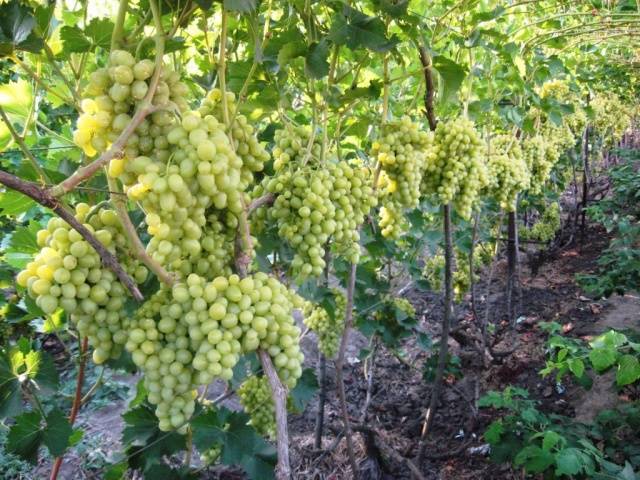
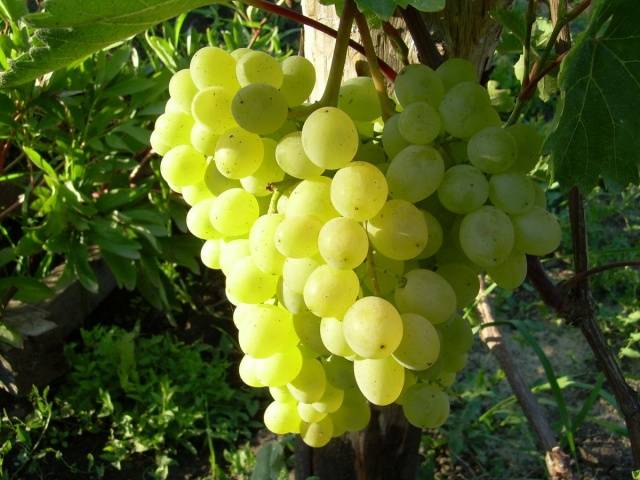

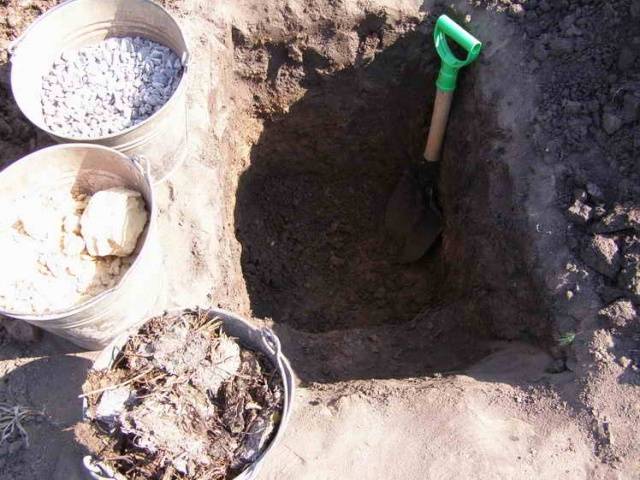
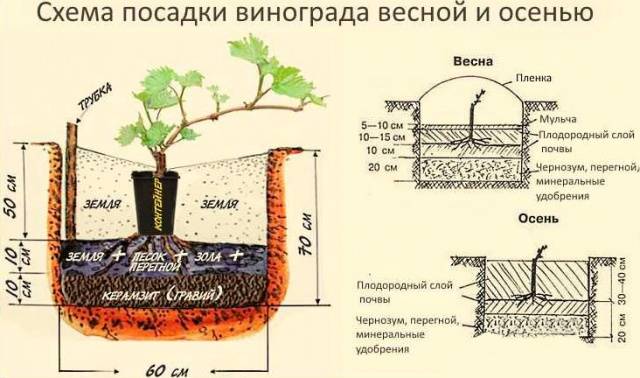


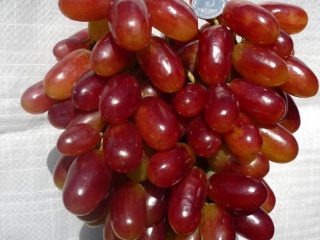
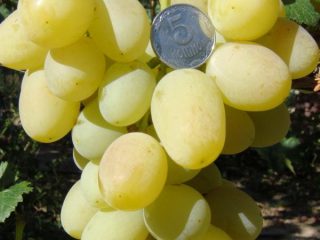

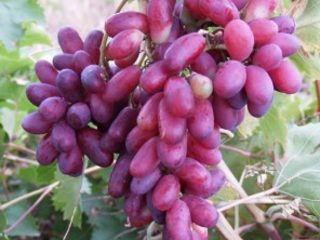
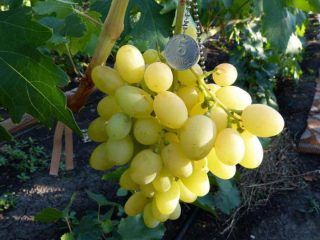
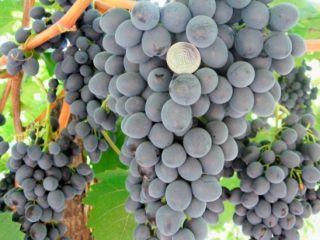
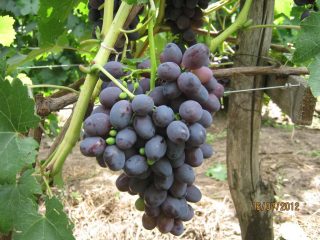
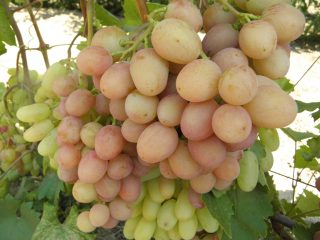
The Tukai grapes are very tasty, early, resistant to diseases. I decided to replace the entire Aleshenkinogo variety with Tukai. Although Aleshenkinogo’s grapes are much heavier and sweeter than the berries. Still, Tukai definitely has a unique taste with a nutmeg aftertaste.